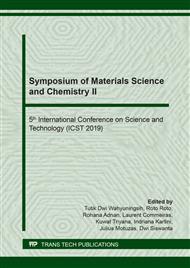p.3
p.10
p.16
p.22
p.29
p.35
p.43
p.48
The Effectiveness Adsorption of Au(III) and Cu(II) Ion by Mangosteen Rind (Garcinia mangostana L.) Using Point of Zero Charge Calculation
Abstract:
Adsorption of Au(III) and Cu(II) by mangosteen rind adsorbent had been carried out. Mangosteen rind has several functional groups including –OH phenolics, ‒C=C‒ aromatics, and ethers. Dried mangosteen rind which was obtained from maceration was used to determine Point of Zero Charge (PZC). The most effective pH adsorption was determined by mixing adsorbent with Au(III) or Cu(II) solutions with various pH. The adsorption capacity was affected by the interaction between adsorbent and adsorbate. The solid adsorbent before and after interaction was characterized by FTIR, XRD, and microphotography. The PZC pH value of adsorbent was 3.7 while the optimum pH for Au(III) and Cu(II) were at pH 2 and pH 5, respectively. The adsorption capacity (qmax) value was 333.33 mg/g by following the Langmuir isotherm equation. The crystalline structure of adsorbent was analyzed using XRD and gave 4 peaks characteristics of gold metal on 2ϴ = 38º, 44º, 64º, and 77º after adsorption which indicated the reduction of Au(III) ions into Au(0).
Info:
Periodical:
Pages:
10-15
Citation:
Online since:
April 2020
Authors:
Keywords:
Price:
Сopyright:
© 2020 Trans Tech Publications Ltd. All Rights Reserved
Share:
Citation:


